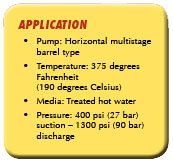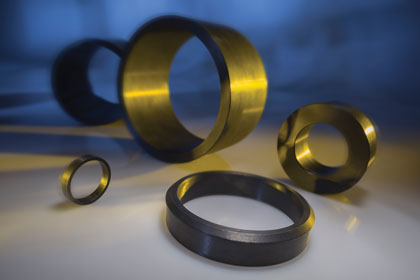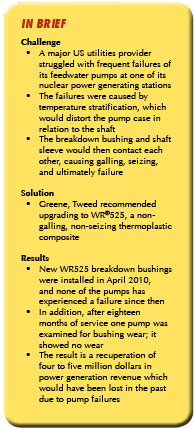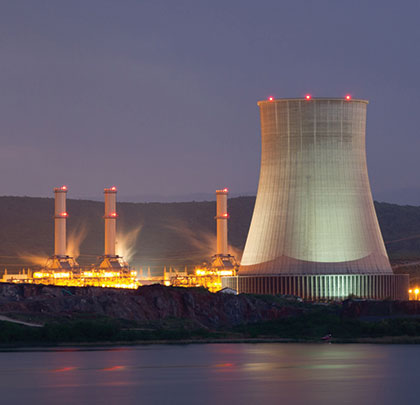Our customer, one of the largest utilities providers in the United States, came to us with a challenge involving one of their nuclear generating stations. Nuclear power plants work by harnessing the thermal energy released from the nucleus of an atom during nuclear fission. Heat is removed from the reactor core by a cooling system and used to generate steam, which drives a steam turbine connected to an electrical generator. Within this system, our customer was experiencing frequent and costly failures of their feedwater pumps. The role of feedwater pumps is to increase the pressure of water coming from the condensate system, forcing it into the steam generator or the reactor.

CHALLENGE
At the nuclear generating station in question, operations were routinely shut down to perform maintenance and refuel the reactors with uranium. Afterward, problems would be encountered trying to re-start the feedwater pumps. The cause of the issue was temperature stratification, which distorted the pump case in relation to the shaft and resulted in the loss of original running clearances. With running clearances no longer uniform, the breakdown bushing and shaft sleeve would contact each other and gall and seize.
In total, there were seven feedwater pumps at the nuclear generating station. Each time one failed, a team of five people would spend seven to ten days repairing the pump. During this time the plant would be running at reduced capacity, resulting in a significant loss of revenue per failure.

SOLUTION
Based on the failure characteristics, Greene, Tweed recommended switching to a new bushing material—WR®525. WR525 is a high-performance thermoplastic composite. With non-galling, non-seizing properties, a low coefficient of thermal expansion, and exceptional thermal shock resistance, it could better withstand startup conditions than the 410SS used at the time.
In engineering new WR®525 breakdown bushings, Greene, Tweed was able to eliminate the original “toothed” design. Breakdown bushings reduce the differential pressure caused by variance in suction and discharge in a pump. In the original design, each labyrinth would act as a successive pressure barrier, with pressure dropping as media advanced from groove to groove. By upgrading to WR525, running clearances could be tighter due to the material’s non-galling, non-seizing properties. These tighter clearances achieved the same pressure reduction intended by the hardened steel, labyrinth design.

RESULTS
The new WR525 breakdown bushings were installed in April 2010. Since then, none of the pumps has experienced an episode of galling, seizing, or failure. In addition, one of the feedwater pumps was examined after eighteen months of service and measured for bushing wear—it showed no wear. The result for our customer is the elimination of future galling and seizing, and a recuperation of four to five million dollars in lost power generation revenue. ■
ABOUT THE AUTHOR
Alex Balvedi is the senior marketing specialist for Greene, Tweed. From a proven suite of elastomers and thermoplastics, to innovative thermoplastic composites and integrated solution offerings, Greene, Tweed is a trusted partner for the most advanced solutions on the market. For more information, visit www.gtweed.com.
MODERN PUMPING TODAY, July 2014
Did you enjoy this article?
Subscribe to the FREE Digital Edition of Modern Pumping Today Magazine!®


